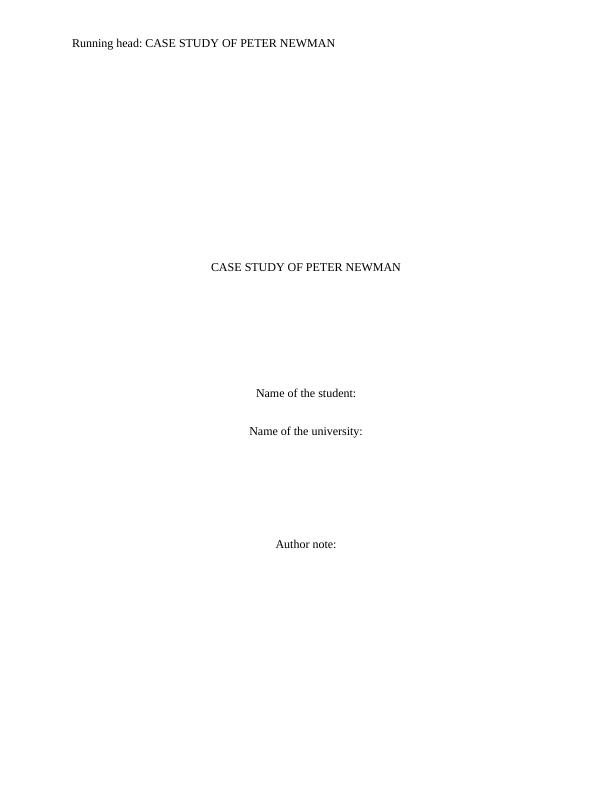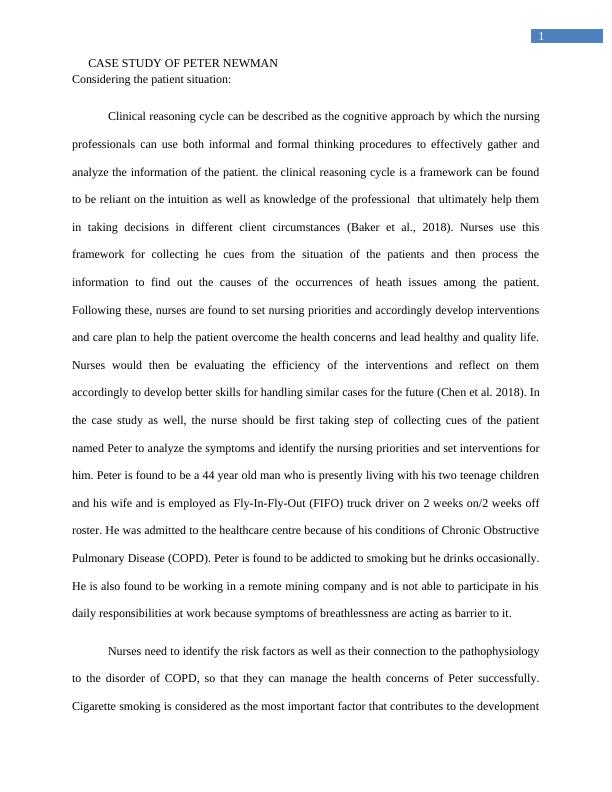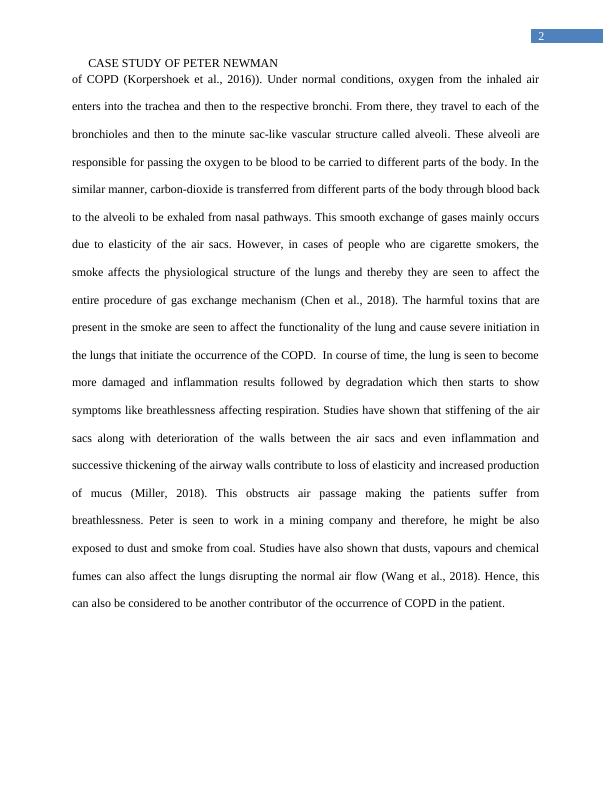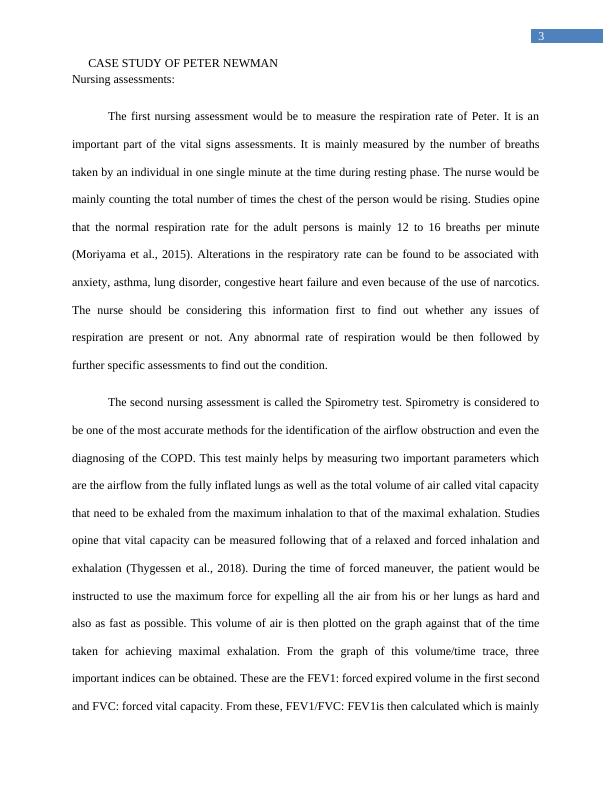Case Study of Peter Newman
Added on 2023-01-17
12 Pages3418 Words95 Views
Running head: CASE STUDY OF PETER NEWMAN
CASE STUDY OF PETER NEWMAN
Name of the student:
Name of the university:
Author note:
CASE STUDY OF PETER NEWMAN
Name of the student:
Name of the university:
Author note:

1
CASE STUDY OF PETER NEWMAN
Considering the patient situation:
Clinical reasoning cycle can be described as the cognitive approach by which the nursing
professionals can use both informal and formal thinking procedures to effectively gather and
analyze the information of the patient. the clinical reasoning cycle is a framework can be found
to be reliant on the intuition as well as knowledge of the professional that ultimately help them
in taking decisions in different client circumstances (Baker et al., 2018). Nurses use this
framework for collecting he cues from the situation of the patients and then process the
information to find out the causes of the occurrences of heath issues among the patient.
Following these, nurses are found to set nursing priorities and accordingly develop interventions
and care plan to help the patient overcome the health concerns and lead healthy and quality life.
Nurses would then be evaluating the efficiency of the interventions and reflect on them
accordingly to develop better skills for handling similar cases for the future (Chen et al. 2018). In
the case study as well, the nurse should be first taking step of collecting cues of the patient
named Peter to analyze the symptoms and identify the nursing priorities and set interventions for
him. Peter is found to be a 44 year old man who is presently living with his two teenage children
and his wife and is employed as Fly-In-Fly-Out (FIFO) truck driver on 2 weeks on/2 weeks off
roster. He was admitted to the healthcare centre because of his conditions of Chronic Obstructive
Pulmonary Disease (COPD). Peter is found to be addicted to smoking but he drinks occasionally.
He is also found to be working in a remote mining company and is not able to participate in his
daily responsibilities at work because symptoms of breathlessness are acting as barrier to it.
Nurses need to identify the risk factors as well as their connection to the pathophysiology
to the disorder of COPD, so that they can manage the health concerns of Peter successfully.
Cigarette smoking is considered as the most important factor that contributes to the development
CASE STUDY OF PETER NEWMAN
Considering the patient situation:
Clinical reasoning cycle can be described as the cognitive approach by which the nursing
professionals can use both informal and formal thinking procedures to effectively gather and
analyze the information of the patient. the clinical reasoning cycle is a framework can be found
to be reliant on the intuition as well as knowledge of the professional that ultimately help them
in taking decisions in different client circumstances (Baker et al., 2018). Nurses use this
framework for collecting he cues from the situation of the patients and then process the
information to find out the causes of the occurrences of heath issues among the patient.
Following these, nurses are found to set nursing priorities and accordingly develop interventions
and care plan to help the patient overcome the health concerns and lead healthy and quality life.
Nurses would then be evaluating the efficiency of the interventions and reflect on them
accordingly to develop better skills for handling similar cases for the future (Chen et al. 2018). In
the case study as well, the nurse should be first taking step of collecting cues of the patient
named Peter to analyze the symptoms and identify the nursing priorities and set interventions for
him. Peter is found to be a 44 year old man who is presently living with his two teenage children
and his wife and is employed as Fly-In-Fly-Out (FIFO) truck driver on 2 weeks on/2 weeks off
roster. He was admitted to the healthcare centre because of his conditions of Chronic Obstructive
Pulmonary Disease (COPD). Peter is found to be addicted to smoking but he drinks occasionally.
He is also found to be working in a remote mining company and is not able to participate in his
daily responsibilities at work because symptoms of breathlessness are acting as barrier to it.
Nurses need to identify the risk factors as well as their connection to the pathophysiology
to the disorder of COPD, so that they can manage the health concerns of Peter successfully.
Cigarette smoking is considered as the most important factor that contributes to the development

2
CASE STUDY OF PETER NEWMAN
of COPD (Korpershoek et al., 2016)). Under normal conditions, oxygen from the inhaled air
enters into the trachea and then to the respective bronchi. From there, they travel to each of the
bronchioles and then to the minute sac-like vascular structure called alveoli. These alveoli are
responsible for passing the oxygen to be blood to be carried to different parts of the body. In the
similar manner, carbon-dioxide is transferred from different parts of the body through blood back
to the alveoli to be exhaled from nasal pathways. This smooth exchange of gases mainly occurs
due to elasticity of the air sacs. However, in cases of people who are cigarette smokers, the
smoke affects the physiological structure of the lungs and thereby they are seen to affect the
entire procedure of gas exchange mechanism (Chen et al., 2018). The harmful toxins that are
present in the smoke are seen to affect the functionality of the lung and cause severe initiation in
the lungs that initiate the occurrence of the COPD. In course of time, the lung is seen to become
more damaged and inflammation results followed by degradation which then starts to show
symptoms like breathlessness affecting respiration. Studies have shown that stiffening of the air
sacs along with deterioration of the walls between the air sacs and even inflammation and
successive thickening of the airway walls contribute to loss of elasticity and increased production
of mucus (Miller, 2018). This obstructs air passage making the patients suffer from
breathlessness. Peter is seen to work in a mining company and therefore, he might be also
exposed to dust and smoke from coal. Studies have also shown that dusts, vapours and chemical
fumes can also affect the lungs disrupting the normal air flow (Wang et al., 2018). Hence, this
can also be considered to be another contributor of the occurrence of COPD in the patient.
CASE STUDY OF PETER NEWMAN
of COPD (Korpershoek et al., 2016)). Under normal conditions, oxygen from the inhaled air
enters into the trachea and then to the respective bronchi. From there, they travel to each of the
bronchioles and then to the minute sac-like vascular structure called alveoli. These alveoli are
responsible for passing the oxygen to be blood to be carried to different parts of the body. In the
similar manner, carbon-dioxide is transferred from different parts of the body through blood back
to the alveoli to be exhaled from nasal pathways. This smooth exchange of gases mainly occurs
due to elasticity of the air sacs. However, in cases of people who are cigarette smokers, the
smoke affects the physiological structure of the lungs and thereby they are seen to affect the
entire procedure of gas exchange mechanism (Chen et al., 2018). The harmful toxins that are
present in the smoke are seen to affect the functionality of the lung and cause severe initiation in
the lungs that initiate the occurrence of the COPD. In course of time, the lung is seen to become
more damaged and inflammation results followed by degradation which then starts to show
symptoms like breathlessness affecting respiration. Studies have shown that stiffening of the air
sacs along with deterioration of the walls between the air sacs and even inflammation and
successive thickening of the airway walls contribute to loss of elasticity and increased production
of mucus (Miller, 2018). This obstructs air passage making the patients suffer from
breathlessness. Peter is seen to work in a mining company and therefore, he might be also
exposed to dust and smoke from coal. Studies have also shown that dusts, vapours and chemical
fumes can also affect the lungs disrupting the normal air flow (Wang et al., 2018). Hence, this
can also be considered to be another contributor of the occurrence of COPD in the patient.

3
CASE STUDY OF PETER NEWMAN
Nursing assessments:
The first nursing assessment would be to measure the respiration rate of Peter. It is an
important part of the vital signs assessments. It is mainly measured by the number of breaths
taken by an individual in one single minute at the time during resting phase. The nurse would be
mainly counting the total number of times the chest of the person would be rising. Studies opine
that the normal respiration rate for the adult persons is mainly 12 to 16 breaths per minute
(Moriyama et al., 2015). Alterations in the respiratory rate can be found to be associated with
anxiety, asthma, lung disorder, congestive heart failure and even because of the use of narcotics.
The nurse should be considering this information first to find out whether any issues of
respiration are present or not. Any abnormal rate of respiration would be then followed by
further specific assessments to find out the condition.
The second nursing assessment is called the Spirometry test. Spirometry is considered to
be one of the most accurate methods for the identification of the airflow obstruction and even the
diagnosing of the COPD. This test mainly helps by measuring two important parameters which
are the airflow from the fully inflated lungs as well as the total volume of air called vital capacity
that need to be exhaled from the maximum inhalation to that of the maximal exhalation. Studies
opine that vital capacity can be measured following that of a relaxed and forced inhalation and
exhalation (Thygessen et al., 2018). During the time of forced maneuver, the patient would be
instructed to use the maximum force for expelling all the air from his or her lungs as hard and
also as fast as possible. This volume of air is then plotted on the graph against that of the time
taken for achieving maximal exhalation. From the graph of this volume/time trace, three
important indices can be obtained. These are the FEV1: forced expired volume in the first second
and FVC: forced vital capacity. From these, FEV1/FVC: FEV1is then calculated which is mainly
CASE STUDY OF PETER NEWMAN
Nursing assessments:
The first nursing assessment would be to measure the respiration rate of Peter. It is an
important part of the vital signs assessments. It is mainly measured by the number of breaths
taken by an individual in one single minute at the time during resting phase. The nurse would be
mainly counting the total number of times the chest of the person would be rising. Studies opine
that the normal respiration rate for the adult persons is mainly 12 to 16 breaths per minute
(Moriyama et al., 2015). Alterations in the respiratory rate can be found to be associated with
anxiety, asthma, lung disorder, congestive heart failure and even because of the use of narcotics.
The nurse should be considering this information first to find out whether any issues of
respiration are present or not. Any abnormal rate of respiration would be then followed by
further specific assessments to find out the condition.
The second nursing assessment is called the Spirometry test. Spirometry is considered to
be one of the most accurate methods for the identification of the airflow obstruction and even the
diagnosing of the COPD. This test mainly helps by measuring two important parameters which
are the airflow from the fully inflated lungs as well as the total volume of air called vital capacity
that need to be exhaled from the maximum inhalation to that of the maximal exhalation. Studies
opine that vital capacity can be measured following that of a relaxed and forced inhalation and
exhalation (Thygessen et al., 2018). During the time of forced maneuver, the patient would be
instructed to use the maximum force for expelling all the air from his or her lungs as hard and
also as fast as possible. This volume of air is then plotted on the graph against that of the time
taken for achieving maximal exhalation. From the graph of this volume/time trace, three
important indices can be obtained. These are the FEV1: forced expired volume in the first second
and FVC: forced vital capacity. From these, FEV1/FVC: FEV1is then calculated which is mainly

End of preview
Want to access all the pages? Upload your documents or become a member.
Related Documents
Case Study on Peter Mitchelllg...
|9
|2449
|117
Chronic Obstructive Pulmonary Disease Assignmentlg...
|7
|1673
|19
Medical Surgical Nursing Care Plan for COPD Patientlg...
|11
|4987
|99
Clinical Decision-Making base on Case Studylg...
|15
|4479
|16
(NUR250)-Nursing Care Plan for COPD Patient with Risk Factorslg...
|12
|4243
|98
Care of the Person with a Medical Conditionlg...
|16
|4291
|73
